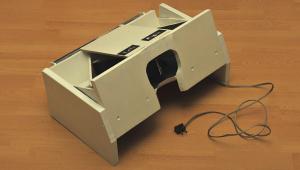On The Road; Parade Route; My Strategies For Festivals And Events Page 2
 |
|
|
I always carry Speedlights. I can’t control the time of day the parade will take place, or the time of day the best pictures might happen, and I have to be able to use fill flash, especially in the midday sun. I use my camera’s built-in flash and hot shoe Speedlights separately and in combination. I find the little pop-up flashes to be outstanding, especially when I’m doing portraits; they’re great up to 10 or 15 feet. I travel with two Speedlights, but often carry only one for a festival or event because I have the pop-up flash. Sometimes I’ll take the Speedlight off the camera and use it, handheld and wirelessly, with the pop-up flash.
The advantage of using the bigger flash on the camera rather than the pop-up is that I can configure the camera to work in high-speed flash mode and use it all the way up to 1⁄8000 sec. Many times during the day I find that I want to use a shallow depth of field—f/2.8 or f/4, for instance—with flash. In those cases I need a fast shutter speed because with flash and a bright day, I’d have too much light, and it’s the fast shutter speed that keeps me from overexposing the image. The drawback is that in high-speed use, the flash’s power is cut down quite a bit, so I can’t be too far away from my subject. One trick I sometimes use is to rubber band two flash units together and hold both of them to double the power.
 |
|
|
I’ll use center-weighted and Matrix metering. For a day with lots of color and shades of light and dark, Matrix works well, but sometimes I find I’m not getting the type of exposure I want with flash, so I’ll switch to center-weighted because it concentrates a little bit more on what’s happening in the center of the frame, where the flash is having its greatest effect.
I have the camera set for continuous autofocus most of the time whenever I’m shooting a festival that’s in full swing; to keep things sharp it’s always good to have the lens working with you. And while I do set the camera for motor drive, it’s usually not high-speed operation. I like to be able to get off a three- or four-frame burst when things are happening; that’s about the maximum for me (most of the time my flash is set with some kind of flash exposure compensation, so it’ll use a fraction of its power, which helps the flash keep up with the motor drive).
 |
|
|
The other thing I keep in mind always is the background. I’ll position myself and choose my lens to avoid distracting backgrounds, but I most often end up using depth of field to control how much of the background is obvious. One of the nicest things about festivals and parades is that the backgrounds are often as colorful as the subjects, and with a shallow depth of field, colorful backgrounds can take on a pastel, almost painted look that really sets off the main subject.
Maynard Switzer’s website (www.maynardswitzer.com) features several portfolios of his travel images.
- Log in or register to post comments

















































